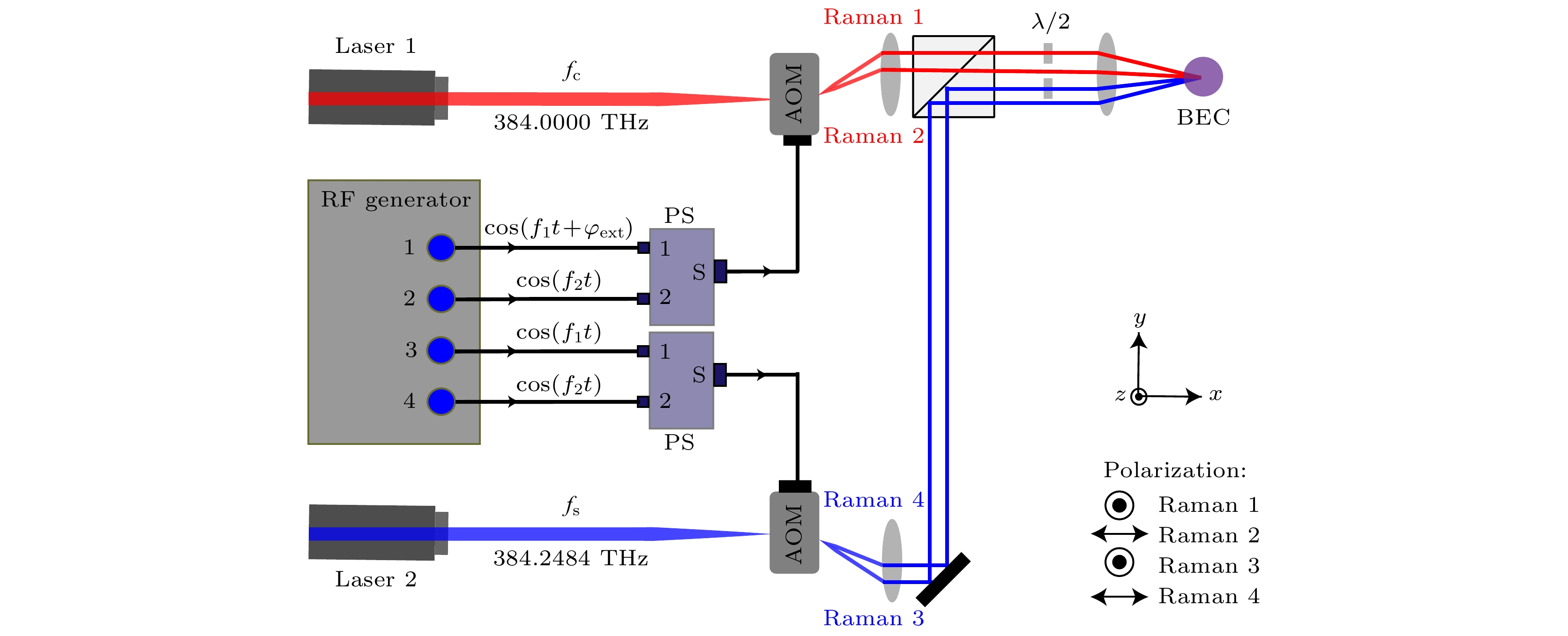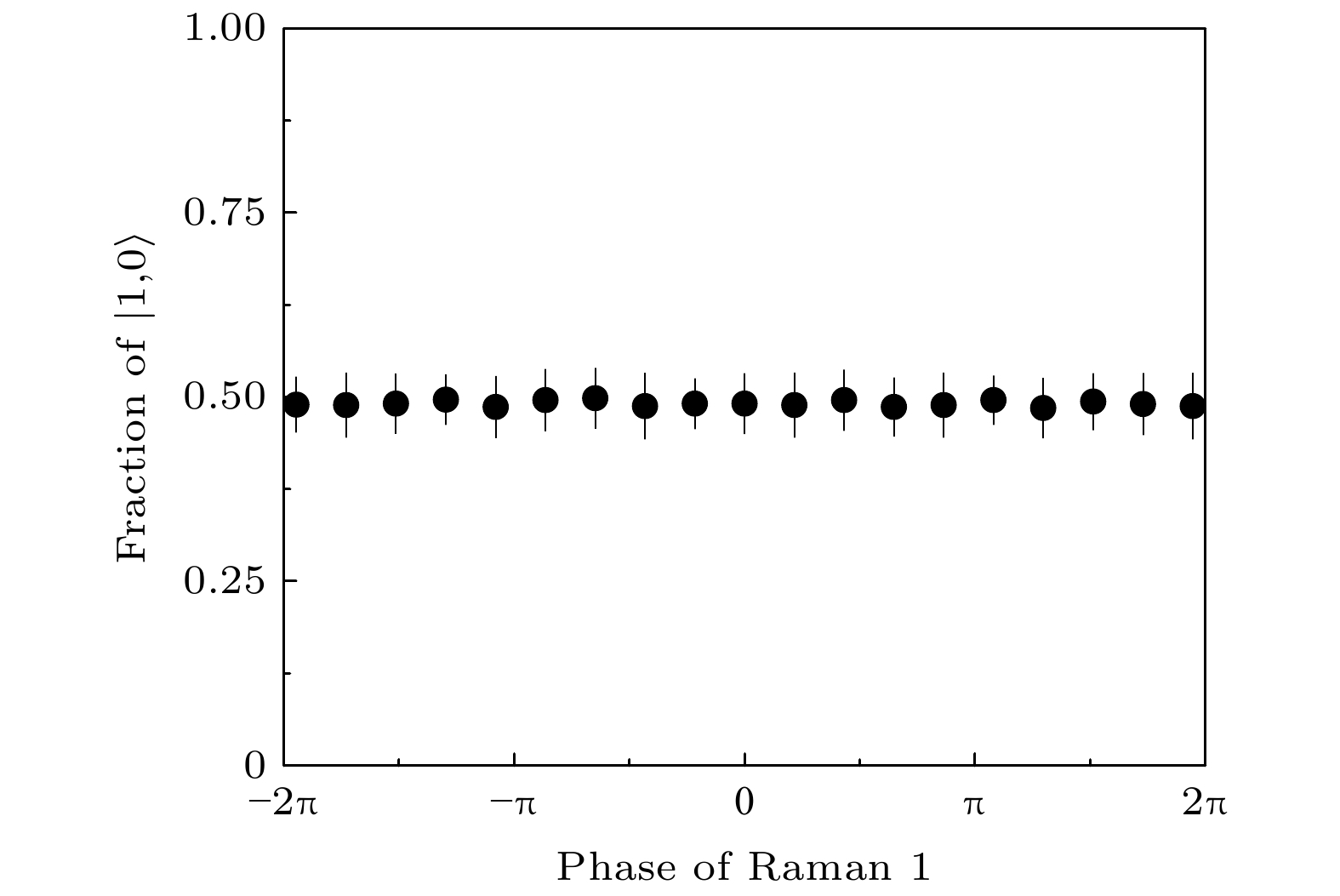-
In this paper, we develop a new method to adjust the Raman coupling strength by using the relative phase between two pairs of Raman lasers. The stimulated Raman transition process is highly controllable and has the characteristics of multiple degrees of freedom. In experiments on ultracold atoms, the populations of atomic energy levels can be adjusted by taking an appropriate Raman light intensity and interaction time, and by detuning the two-photon frequency. The intensity of the Raman laser is usually changed to adjust the Raman coupling strength. Based on two-level atoms, a new method of accurately controlling the Raman coupling strength by using the relative phase between two pairs of Raman light beams is developed. This technology can achieve coherent manipulation of atomic quantum states, which greatly broadens the ability of ultracold atoms to perform quantum simulations. First, the 87Rb Bose-Einstein condensate is realized by using an optical dipole trap. Then, the two pairs of Raman lasers are designed with a special optical path to keep the relative phase of the two pairs of Raman lasers stable in the transmission process, and can be controlled accurately. Then the two pairs of Raman light beams act on the two ground state hyperfine energy levels
$ |1, 1\rangle $ and$ |1, 0\rangle $ of the 87Rb atom. In the experiment, we observe the relation between the percentage of atoms in the two quantum states and the relative phase between the two pairs of Raman light beams. This method provides a unique control parameter for ultracold atom quantum simulation experiments, which is the laser phase. It is hoped that this technology can be used to manipulate the interaction between light and atoms in the future to achieve more abundant physical phenomena.-
Keywords:
- stimulated Raman transition /
- laser phase /
- Raman coupling strength /
- three-level atomic system
[1] Gaubatz U, Rudecki P, Schiemann S, Bergmann K 1990 J. Chem. Phys. 92 5363
 Google Scholar
Google Scholar
[2] Vitanov N V, Rangelov A A, Shore B W, Bergmann K 2017 Rev. Mod. Phys. 89 015006
 Google Scholar
Google Scholar
[3] Kasevich M, Chu S 1992 Appl. Phys. B 54 321
 Google Scholar
Google Scholar
[4] Kasevich M, Chu S 1991 Phys. Rev. Lett. 67 181
 Google Scholar
Google Scholar
[5] Kasevich M, Chu S 1992 Phys. Rev. Lett. 69 1741
 Google Scholar
Google Scholar
[6] Davidson N, Lee H J, Kasevich M, Chu S 1994 Phys. Rev. Lett. 72 3158
 Google Scholar
Google Scholar
[7] Boyer V, Lising L J, Rolston S L, Phillips W D 2004 Phys. Rev. A 70 043405
 Google Scholar
Google Scholar
[8] Reichel J, Morice O, Tino G M, Salomon C 1994 Europhys. Lett. 28 477
 Google Scholar
Google Scholar
[9] Law C K, Eberly J H 1998 Opt. Express 2 368
 Google Scholar
Google Scholar
[10] Paparelle I, Moro L, Prati E 2020 Phys. Lett. A 384 126266
 Google Scholar
Google Scholar
[11] Ringot J, Szriftgiser P, Garreau J C 2001 Phys. Rev. A 65 013403
 Google Scholar
Google Scholar
[12] Thomas J E, Hemmer P R, Ezekiel S, Leiby C C, Picard R H, Willis C R 1982 Phys. Rev. Lett. 48 867
 Google Scholar
Google Scholar
[13] Xu Z X, Wu Y L, Tian L, Chen L R, Zhang Z Y, Yan Z H, Li S J, Wang H, Xie C D, Peng K C 2013 Phys. Rev. Lett. 111 240503
 Google Scholar
Google Scholar
[14] Král P, Shapiro M 2001 Phys. Rev. Lett. 87 183002
 Google Scholar
Google Scholar
[15] Thanopulos I, Král P, Shapiro M 2003 J. Chem. Phys. 119 5105
 Google Scholar
Google Scholar
[16] Fu Z K, Wang P J, Chai S J, Huang L H, Zhang J 2011 Phys. Rev. A 84 043609
 Google Scholar
Google Scholar
[17] Lin Y J, Compton R L, Perry A R, Phillips W D, Porto J V, Spielman I B 2009 Phys. Rev. Lett. 102 130401
 Google Scholar
Google Scholar
[18] Spielman I B 2009 Phys. Rev. A 79 063613
 Google Scholar
Google Scholar
[19] Lin Y J, Compton R L, Jiménez-García K, Porto J V, Spielman I B 2009 Nature 462 628
 Google Scholar
Google Scholar
[20] Lin Y J, Jiménez-García K, Spielman I B 2011 Nature 471 83
 Google Scholar
Google Scholar
[21] Wang P J, Yu Z Q, Fu Z K, Miao J, Huang L H, Chai S J, Zhai H, Zhang J 2012 Phys. Rev. Lett. 109 095301
 Google Scholar
Google Scholar
[22] Huang L H, Meng Z M, Wang P J, Peng P, Zhang S L, Chen L C, Li D H, Zhou Q, Zhang J 2016 Nat. Phys. 12 540
 Google Scholar
Google Scholar
[23] Ozawa T, Price H M 2019 Nat. Rev. Phys. 1 349
 Google Scholar
Google Scholar
[24] Meng Z M, Huang L H, Peng P, Li D H, Chen L C, Xu Y, Zhang C W, Wang P J, Zhang J 2016 Phys. Rev. Lett. 117 235304
 Google Scholar
Google Scholar
[25] Wu Z, Zhang L, Sun W, Xu X T, Wang B Z, Ji S C, Deng Y J, Chen S, Liu X J, Pan J W 2016 Science 354 83
 Google Scholar
Google Scholar
[26] Zhang D F, Gao T Y, Zou P, Kong L G, Li R Z, Shen X, Chen X L, Peng S G, Zhan M S, Pu H, Jiang K J 2019 Phys. Rev. Lett. 122 110402
 Google Scholar
Google Scholar
[27] Zhai H 2012 Int. J. Mod. Phys. B 26 1230001
 Google Scholar
Google Scholar
-
图 6 实验测量量子态
$ \left| {{\rm{1}}, {\rm{0}}} \right\rangle $ 的布居数随两对拉曼光间的相对相位的变化关系. 红色实线使用的钛宝石激光器1, 2输出频率分别为:$ {f}_{\mathrm{C}}=384.0000\;\mathrm{T}\mathrm{H}\mathrm{z} $ ,$ {f}_{\mathrm{S}}=384.2484\;\mathrm{T}\mathrm{H}\mathrm{z} $ , 红色虚线为理论计算图. 蓝色实线使用的钛宝石激光器1, 2输出频率分别为:$ {f}_{\mathrm{C}}=383.7652\;\mathrm{T}\mathrm{H}\mathrm{z} $ ,$ {f}_{\mathrm{S}}=384.2484\;\mathrm{T}\mathrm{H}\mathrm{z} $ , 蓝色虚线为理论计算图Figure 6. Measure the population in
$ \left| {{\rm{1}}, {\rm{0}}} \right\rangle $ as a function of phase of four Raman lasers. The red solid line:$ {f}_{\mathrm{C}}=384.0000\;\mathrm{T}\mathrm{H}\mathrm{z} $ ,$ {f}_{\mathrm{S}}=384.2484\;\mathrm{T}\mathrm{H}\mathrm{z} $ . The blue solid line:$ {f}_{\mathrm{C}}=383.7652\;\mathrm{T}\mathrm{H}\mathrm{z} $ ,$ {f}_{\mathrm{S}}=384.2484\;\mathrm{T}\mathrm{H}\mathrm{z} $ . The red and blue dotted line is the theoretical diagram. -
[1] Gaubatz U, Rudecki P, Schiemann S, Bergmann K 1990 J. Chem. Phys. 92 5363
 Google Scholar
Google Scholar
[2] Vitanov N V, Rangelov A A, Shore B W, Bergmann K 2017 Rev. Mod. Phys. 89 015006
 Google Scholar
Google Scholar
[3] Kasevich M, Chu S 1992 Appl. Phys. B 54 321
 Google Scholar
Google Scholar
[4] Kasevich M, Chu S 1991 Phys. Rev. Lett. 67 181
 Google Scholar
Google Scholar
[5] Kasevich M, Chu S 1992 Phys. Rev. Lett. 69 1741
 Google Scholar
Google Scholar
[6] Davidson N, Lee H J, Kasevich M, Chu S 1994 Phys. Rev. Lett. 72 3158
 Google Scholar
Google Scholar
[7] Boyer V, Lising L J, Rolston S L, Phillips W D 2004 Phys. Rev. A 70 043405
 Google Scholar
Google Scholar
[8] Reichel J, Morice O, Tino G M, Salomon C 1994 Europhys. Lett. 28 477
 Google Scholar
Google Scholar
[9] Law C K, Eberly J H 1998 Opt. Express 2 368
 Google Scholar
Google Scholar
[10] Paparelle I, Moro L, Prati E 2020 Phys. Lett. A 384 126266
 Google Scholar
Google Scholar
[11] Ringot J, Szriftgiser P, Garreau J C 2001 Phys. Rev. A 65 013403
 Google Scholar
Google Scholar
[12] Thomas J E, Hemmer P R, Ezekiel S, Leiby C C, Picard R H, Willis C R 1982 Phys. Rev. Lett. 48 867
 Google Scholar
Google Scholar
[13] Xu Z X, Wu Y L, Tian L, Chen L R, Zhang Z Y, Yan Z H, Li S J, Wang H, Xie C D, Peng K C 2013 Phys. Rev. Lett. 111 240503
 Google Scholar
Google Scholar
[14] Král P, Shapiro M 2001 Phys. Rev. Lett. 87 183002
 Google Scholar
Google Scholar
[15] Thanopulos I, Král P, Shapiro M 2003 J. Chem. Phys. 119 5105
 Google Scholar
Google Scholar
[16] Fu Z K, Wang P J, Chai S J, Huang L H, Zhang J 2011 Phys. Rev. A 84 043609
 Google Scholar
Google Scholar
[17] Lin Y J, Compton R L, Perry A R, Phillips W D, Porto J V, Spielman I B 2009 Phys. Rev. Lett. 102 130401
 Google Scholar
Google Scholar
[18] Spielman I B 2009 Phys. Rev. A 79 063613
 Google Scholar
Google Scholar
[19] Lin Y J, Compton R L, Jiménez-García K, Porto J V, Spielman I B 2009 Nature 462 628
 Google Scholar
Google Scholar
[20] Lin Y J, Jiménez-García K, Spielman I B 2011 Nature 471 83
 Google Scholar
Google Scholar
[21] Wang P J, Yu Z Q, Fu Z K, Miao J, Huang L H, Chai S J, Zhai H, Zhang J 2012 Phys. Rev. Lett. 109 095301
 Google Scholar
Google Scholar
[22] Huang L H, Meng Z M, Wang P J, Peng P, Zhang S L, Chen L C, Li D H, Zhou Q, Zhang J 2016 Nat. Phys. 12 540
 Google Scholar
Google Scholar
[23] Ozawa T, Price H M 2019 Nat. Rev. Phys. 1 349
 Google Scholar
Google Scholar
[24] Meng Z M, Huang L H, Peng P, Li D H, Chen L C, Xu Y, Zhang C W, Wang P J, Zhang J 2016 Phys. Rev. Lett. 117 235304
 Google Scholar
Google Scholar
[25] Wu Z, Zhang L, Sun W, Xu X T, Wang B Z, Ji S C, Deng Y J, Chen S, Liu X J, Pan J W 2016 Science 354 83
 Google Scholar
Google Scholar
[26] Zhang D F, Gao T Y, Zou P, Kong L G, Li R Z, Shen X, Chen X L, Peng S G, Zhan M S, Pu H, Jiang K J 2019 Phys. Rev. Lett. 122 110402
 Google Scholar
Google Scholar
[27] Zhai H 2012 Int. J. Mod. Phys. B 26 1230001
 Google Scholar
Google Scholar
Catalog
Metrics
- Abstract views: 6815
- PDF Downloads: 120
- Cited By: 0

















 DownLoad:
DownLoad:



















